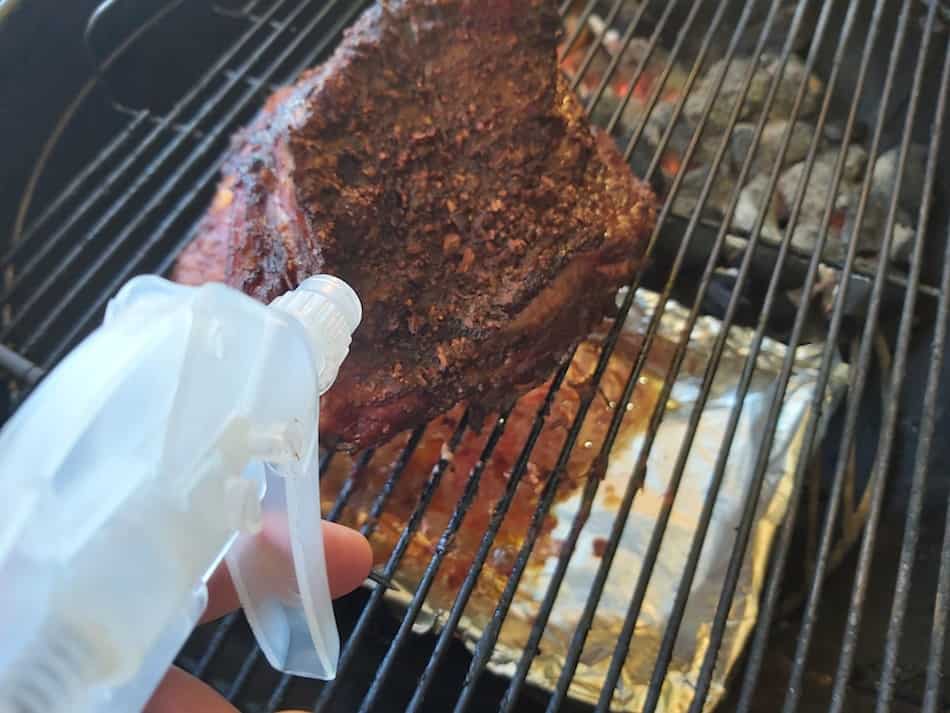
Spritzing pulled pork during the cook is an important part of the smoking process. If you want tender, juicy pulled pork, spritzing is one of the best techniques to reduce the likelihood of dry meat.
It’s important not to spritz too early, otherwise the rub will wash off the meat, leaving a patchy bark. Once the rub has set, only then should you spritz the pork. Then, spritz the meat every 30 to 45 minutes until you wrap the pork in aluminium foil. For the spritz liquid, use apple cider vinegar, or apple juice in a spray bottle. Continue wetting the surface of meat before wrapping in foil. Before closing the wrapping, give the pork one last spritz.
During the first few hours, you don’t need to spritz your pork butt. During the first few hours, is all about developing a nice crusty outer layer. After three or four hours, touch the surface of the meat with your finger. If the rub sticks to your finger, then it’s too soon to spritz. If you spritz the pulled pork too soon, the barbecue rub will wash off the meat.
Spritzing Information |
|---|
| Spritzing is important for ensuring tender and juicy meat |
| Wait until rub has set before spritzing |
| Spritz every 30-45 minutes until wrapped in aluminum foil |
| Popular spritz liquids include apple cider vinegar, apple juice, beer, water, hot sauce and water, wine, broth, and stock |
| Spritzing slows down the cook and helps to break down connective tissue |
| Don’t spritz too soon as it can wash off the rub and leave a patchy bark |
| Don’t over-spritz as it can cause temperature fluctuation in the smoker |
Quick Tips
- Spritzing pulled pork is an important step in smoking process to ensure tender and juicy meat
- Wait until rub has set before spritzing, and then spritz every 30-45 minutes until wrapped in aluminum foil
- Popular spritz liquids include apple cider vinegar, apple juice, beer, water, hot sauce and water, wine, broth, and stock
- Spritzing slows down the cook, helps to hold the meat at low temperature and breaks down connective tissue
- Don’t spritz too soon, as it can wash off the rub and leave a patchy bark
- Don’t over-spritz, as it can cause temperature fluctuation in the smoker
- Mopping is another way to add liquid to pulled pork, but spritzing is quicker and cleaner
- Wrap pulled pork once the bark has set and is cracking, usually after a few hours of smoking
- Cook pork butt until it reaches an internal temperature of 200°F.
The Best Spritz For Pulled Pork
There are lots of different spritz liquids you can use when smoking pork butt for pulled pork. Sticky acidic liquids work best. The extra stickiness helps the smoke stick to the surface of the meat, making a smokier pork butt. Apple cider vinegar, apple juice or beer are popular spritzes for pork. The most common spritzes are:
- Apple cider vinegar
- Apple juice
- Beer
- Water
- Hot sauce and water
- Wine
- Broth
- Stock
Why Spritz Pulled Pork?
Spritzing is beneficial for several reasons. First, spritzing slows down the cook. Low-and-slow cooking is all about holding the meat at low temperature for as long as possible. Pork shoulder is a tough cut of meat. To break down all the connective tissue, pork butt needs a long time at a low temperature. Wetting the meat will cool the meat and slow its journey to a final destination of a 200°F internal temperature.
When smoking pork butt, we are aiming for an internal temperature of 200°F. However, we don’t want to rush the pork. We want to take our time, and slow down the cook.
What Should I Spritz Pork With?
Apple cider vinegar or apple juice are the most common spritz used for pulled pork, but you can use your imagination. Aaron Franklin sometimes uses hot sauce mixed with water.
When making a spritz, be careful not to put large herbs and spices into the spritz bottle. Large spices may get caught in the nozzle and block the spray bottle.
Don’t Spritz Too Soon
Don’t spritz the pork too soon. If you want delicious pulled pork with a crunchy bark, let the outer layer set before spritzing. Smoking the perfect pulled pork is all about building layers of flavor on the outside of the meat.You get one layer of flavor from the rub, and another layer of flavor from the smoke. Spritzing the pork too soon will wash off the rub, leaving a patchy bark.
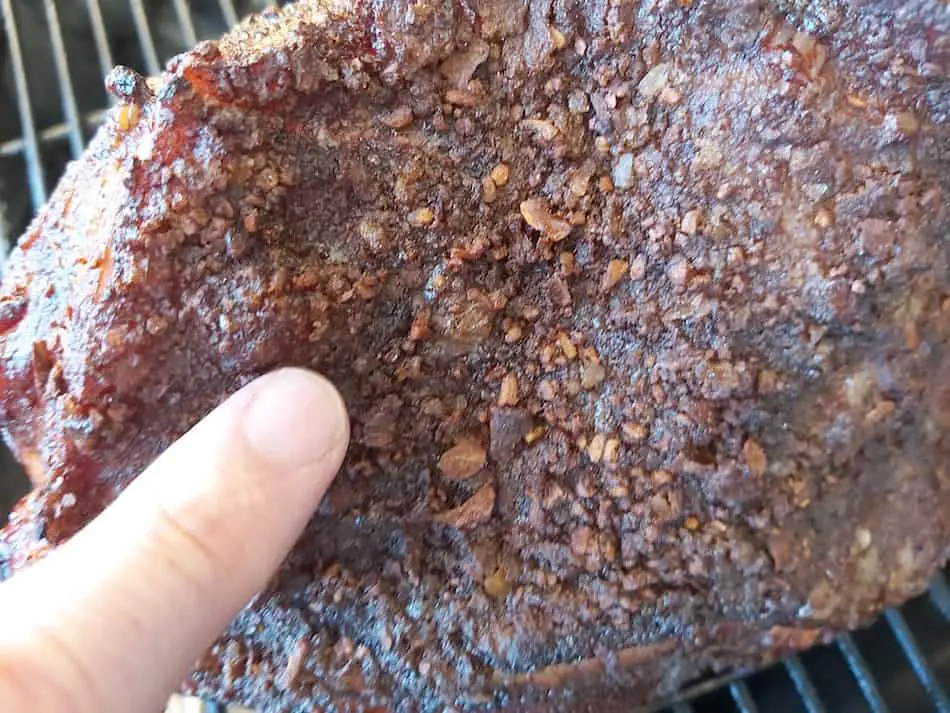
Don’t Over Spritz
Constantly spritzing the meat during the first few hours of the cook will cause the temperature of your smoker to fluctuate. If it’s cold outside, constantly opening the lid to spritz will destabilize your smoker. All the heat you’ve worked so hard to retain will get sucked out. It can also go in the other direction if the fire gets a huge shot of oxygen. This can send the temperature soaring. Then your pork is at risk of drying out.
What About Mopping?
Mopping is another way to add liquid to your pulled pork while smoking. If you haven’t seen these, you can get a miniature mop and bucket, make a sauce, then baste the pork intermittently. I prefer to spritz because it’s quicker and cleaner. Plus, it does the same job.
When To Wrap Pulled Pork
The best time to wrap pulled pork is once the bark has set and is cracking. During the first few hours, the meat will absorb lots of smoke. Once the pork is a nice mahogany color, and cracks are forming in the bark, then it’s time to wrap. You can either wrap the pork in aluminium foil or butcher paper.
When Is Pork Butt Done?
You want to cook pork butt until it reaches an internal temperature of 200°F. The other way you can tell work is ready is by performing tenderness tests. Do this by twisting the bone. If it comes off clean, the meat is tender.
The other way is to perform a toothpick test. Poke the meat with a toothpick or a thermometer probe. When pork has reached perfect tenderness, it should feel like poking a stick of butter.
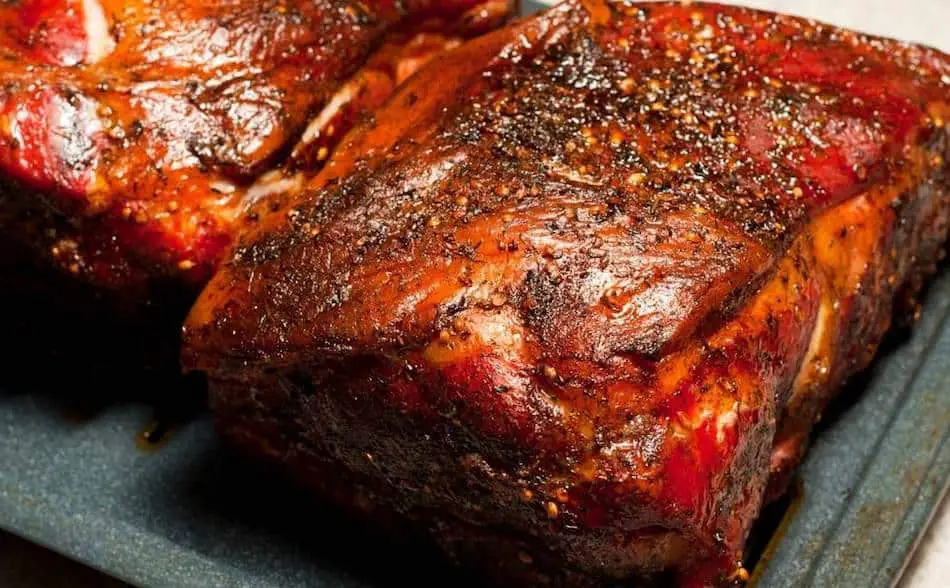
What Meat Is Used To Make Pulled Pork?
The best meat for pulled pork shoulder, also known as pork butt, or Boston butt. This delicious cut of pork contains a lot of fat and connective tissue, which gives the meat an enormous flavor. The shoulder is a hard-working muscle that contains lots of fat and connective tissue. The only way to break down this sinew is by cooking low-and-slow over many hours.
When choosing a pork shoulder for pulled pork, buy one with a large money muscle. Also, try to get a pork butt with a bone. Don’t get a lean butt either. You want some fat for flavor and moisture.
Do You Have To Spritz Pulled Pork?
Spritzing has its advantages, but it’s not absolutely necessary. Barbecue techniques such as wrapping, spritzing, injecting, and brining are different ways to help you get the best results. However, none of these methods are mandatory. Regular spritzing is just one of the many techniques recommend by pitmasters to increase your chances of tender, juicy pulled pork.
The Best Rub For Pulled Pork
There are several good barbecue rubs on the market, but the best pre-made rubs are Harry Soo’s Slap Yo Daddy and Malcolm Reed’s Killer Hugs. Barbecue pitmasters make these rubs, so I guarantee they are good. If you want a good homemade recipe, check out this simple rub.
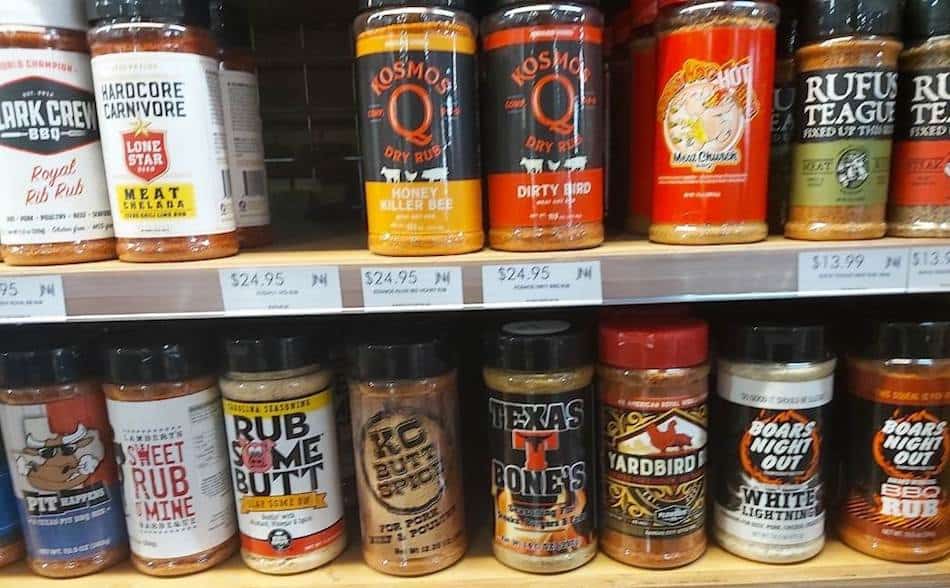
Pork Butt On A Pit Boss Pellet Grill - 12 Steps
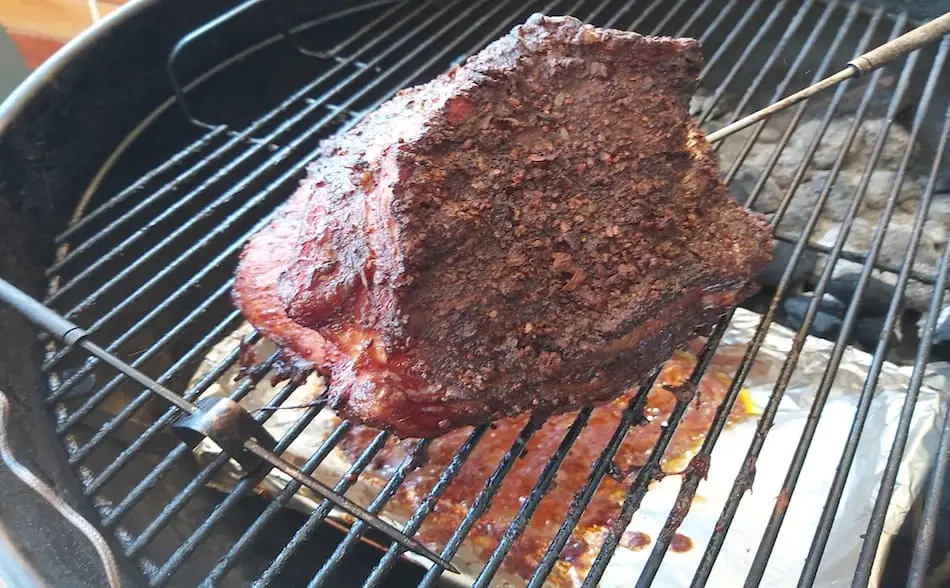
Slow smoked pork butt, ideal for pulled pork.
Ingredients
- Pork butt (Shoulder)
- Barbecue rub
- Apple cider vinegar or apple juice (spritz)
- Olive oil or yellow mustard (binder)
Instructions
- Set your PitBoss to 225°F to 250°F (or start low for 4-5 hours, then increase no higher than 275°F).
- Prepare the meat with rub and seasonings
- Place the pork fat side down (on the middle rack of a vertical PitBoss)
- Insert a thermometer probe into the meat
- Let the meat cook for 2-3 hours. Rotate the meat if there are hot spots on your PitBoss (vertical PitBoss grills are hotter towards the back).
- At the 3 to 4 hour mark, begin checking the bark on the pork with your finger. (Don’t spritz until rub has fused to the meat).
- Begin spritzing every 30 to 40 minutes once the bark has set. Use apple cider vinegar, apple juice, or plain water.
- Wrap the pork in foil once the crust has formed and internal meat temperature has reached between 160°F and 170°F.
- Continue cooking the pork butt, increasing the temperature of your PitBoss no higher than 275°F. Alternatively, turn off your PitBoss and finish in the oven.
- Once the internal meat temperature reaches 195°F, begin checking the temperature and tenderness regularly.
- Once the meat reaches 200°F to 205°F and is soft like butter, remove from the heat.
- Allow the pork to rest 30 minutes to 1 hour or place the meat into holding.
Nutrition Information:
Serving Size:
100 gramsAmount Per Serving: Calories: 168
My Favorite Meat Smoking Tools
Thanks for checking out this article. I hope you learned a few things. Here are some of my favorite tools I use when smoking brisket that may be useful to you. These are affiliate links, so if you decide to purchase any of these products, I’ll earn a commission. But in all honesty, these are the tools I recommend to my family and friends who are just starting out.
Meat Thermometer: There are dozens of fancy thermometers on the market, but I still use my trusty TP20. For around $50, I have a high-quality meat thermometer with two probes, and can track the temperature of my smoker with one probe, and my meat with the other probe. The ThermoPro TP20 is an Amazon Best Seller because it’s the easiest thermometer to operate, is durable, highly accurate, and comes with pre-programmed meat settings.
Instant Read Thermometer: Arguably, the second most important tool you need is a fast and accurate instant-read thermometer. These tools play an important role in the latter stages of the cook when the meat needs regular checking in multiple areas. I use the ThermoPro TP19 because it can do everything a ThermaPen can do, but for a fraction of the cost. You can check out the TP19 on Amazon here.
Wireless Thermometer: The latest thermometers on the market have no wires and can be controlled by wi-fi via your phone. Airprobe 3 is the best of this technology.
Butcher Paper: Wrapping brisket in butcher paper has become a huge trend in barbeque thanks to Aaron Franklin. Wrapping your brisket in paper will give you a nice brisket bark. However, you can’t just use any old paper, it has to be unwaxed, food grade paper. You can find it on Amazon here.
Advanced Thermometer and Automatic Temperature Controller: Once you’re ready to take things seriously, the FireBoard 2 Drive is a six-channel Bluetooth/Wi-Fi thermometer that can monitor up to 6 pieces of meat, control and graph your cook sessions on your smartphone, and attaches to an an automatic blower that will convert your charcoal smoker to a set-and-forget. This is one of the most advanced meat thermometers on the market. You can check it out on the FireBoard website here.

